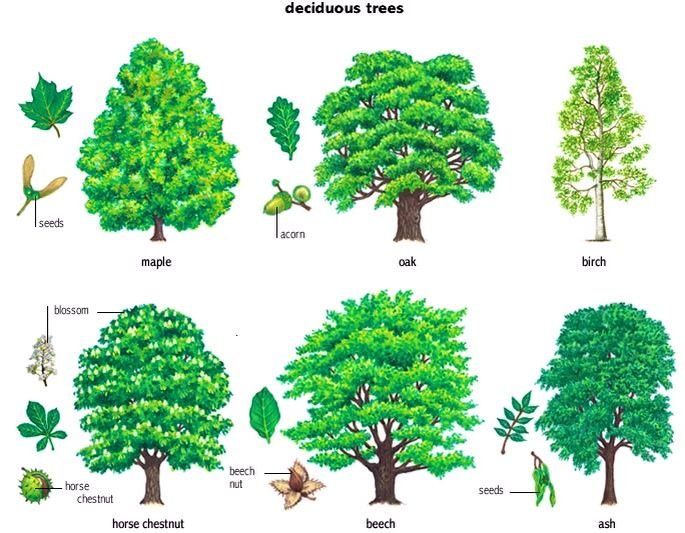Trees Talk to One Another?
Take a card and pencil.
Walk around looking for cards 1-10 hanging on the golden ropes.
You’ll find out about trees and how they talk to one another.
You’ll also build a sentence using the key words found on each card
to answer why you should care.
More info and pictures to go along with the explanations are found below!
Card 1: The Life Cycle of a Tree
Seed -> Seedling
Seedling -> Sapling (tree is > 3 ft tall)
Sapling -> Tree (produces fruit and flowers)
Tree -> Snag (dead or dying)
Card 2: Coniferous Trees
There are over 800 kinds found in nature.
They produce cones.
Card 3: Deciduous Trees
They lose their leaves in the fall/dry season.
A chemical is produced where the leaf & stem meet, making the leaf fall.
Card 4: Mycelia
They are threads you see near roots.
They break down nutrients in the soil.
Mushrooms are their fruit.
Card 5: How Trees use Mycelia
Trees pass water, food and information through the mycelia network.
The mycelia keeps ~30% of the sugars as a fee.
Card 6: Mother Trees
They are the oldest trees with the largest connections.
They send food/info to other trees.
They can sense distressed trees.
Card 7: How scientists found out about this
A scientist sealed in a tree with radioactive CO2.
The tree soaked it up, and made sugars.
Those radioactive sugars were found in nearby trees.
Card 8: Reforestation
Cutting down a birch tree, may kill a nearby fir tree.
Reforesting requires using many kinds of trees.
Card 9: Muir Woods
The Redwoods contain tannin making them red & resistant to decay.
Their bark is at least 1 ft thick; it is also resistant to fire.
Card 10: Pando
Pando is an aspen tree that is the largest organism in the world.
All of the tree clones loose their leaves at the same time.
Want to learn more?
-
Weave information, trees, mycelia and the public together into a collective dance demonstrating to the participant how interwoven our environment is.
-
The public will enter a collection of trees with a maze of ropes strung overhead between the trees; where the ropes will symbolize the mycelia (fungus) underneath the ground. Fungus is infamous for its role in decomposition, but it plays an essential role in trees communicating.
On these ropes, numbered informational cards will hang and direct the participant to learn about: the life cycle of a tree, how trees communicate with one another , and famous woodlands like the Muir Woods or Pando, all while leading them through the maze. The collective and individual experiences will be interwoven, as participants must reach above them in order to pull down another information card. The act of pulling one card down will make another have to presumably hop.
Each day the public dancing and hopping through the maze would be recorded overhead from the bird's eye view.
The public will also be able to observe some of the actual mycelia with provided miniature magnifying glasses and shallow holes designated for viewing purposes.
-
Idea 1: Add a fungus that has bioluminescence to test if it would travel amongst the trees. The installation would run over weeks with a long exposure camera recording.
Can you build a bioluminescent mycelia network?
Idea 2: Echoing the logic of Design I/O’s “Funky Forrest” exhibition, wherein the individual directly controls the experience and subsequently sees their role in the ecosystem. Programmable, luminescent fibers would take the place of the rope web. The fibers could be connected to an app that would denote each tree and cable connection on its interface. The user pick the tree they want to act as and send messages on behalf of the tree. Digitally sending nutrients, water, genetic information to other trees. The abilities of each tree would be dependent on the tree’s characteristics (deciduous or coniferous, young or old, sick or healthy).
The passage of information on the app would be reflected with colored, light-up messages sent between the two trees in real time along the fibers.
-
Mihail JD, Bilyeu L, Lalk SR. Bioluminescence expression during the transition from mycelium to mushroom in three North American Armillaria and Desarmillaria species. Fungal Biol. 2018 Nov;122(11):1064-1068. doi: 10.1016/j.funbio.2018.08.007. Epub 2018 Sep 6. PMID: 30342622.
https://www.npr.org/2020/06/26/882828756/suzanne-simard-how-do-trees-collaborateItem description
Cards and Images:
https://www.woodlandtrust.org.uk/blog/2019/06/tree-lifecycle/
https://conifersociety.org/conifers/articles/what-is-a-conifer-tree/
https://www.coniferousforest.com/plants-trees
https://biologydictionary.net/deciduous-trees/#how-deciduous-trees-lose-their-leaves
https://www.mylo-unleather.com/stories/what-is-mycelium/
https://www.nationalforests.org/blog/underground-mycorrhizal-network
https://podcastnotes.org/radiolab/radiolab-from-tree-to-shining-tree/
https://www.nps.gov/parkhistory/online_books/shirley/sec6.htm
https://www.fs.usda.gov/detail/fishlake/home/?cid=STELPRDB5393641
https://www.nationalparkstraveler.org/2020/10/photography-national-parks-redwood-forests-are-made-vertical-shots
https://www.reddit.com/r/interestingasfuck/comments/68a8uf/this_forest_in_utah_is_a_single_organism_it_is/
https://blog.byjus.com/the-learning-tree/science-feed/talks-mother-tree-baby-trees/
http://www.stephaniespera.com/team.html
https://svs.gsfc.nasa.gov/4565
More advanced: https://sciencing.com/mycelia-microbiology-16448.html










